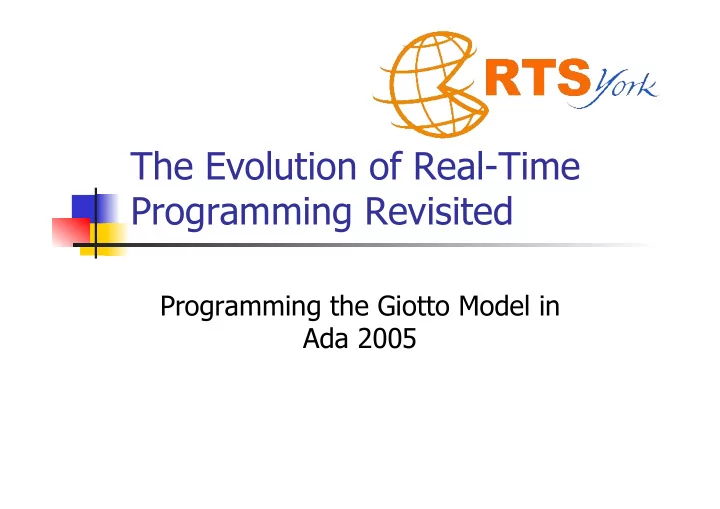

The Evolution of Real-Time Programming Revisited Programming the Giotto Model in Ada 2005
Structure Kirsch and Sengupta original paper Temporal Scopes Giotto Controlling Input and Output Jitter in Ada Conclusions
Kirsch and Segupta Physical execution time model assembly languages Bounded execution time model Ada, Real-Time Java, RTOS Zero execution time model Esterel, Lustre Logical execution time model Giotto
Temporal Scopes Now Deadline Minimum delay a Maximum elapse time b Units of execution c Maximum execution time = a + b +c
Giotto A language for control applications Output produced at deadline, not before A task is logically executing from release to deadline Supports Time Safety and I/O Composability
The Logical Execution-Time Model release termination event event L ogical E xecution T ime Actual Input ports Output ports updated execution updated at at termination event can occur at release event any time
Example – pseudo code sensor port temperature type integer range 10 .. 500 port pressure type integer range 0 .. 750 actuator port heater type (on, off) port pump type integer 0 .. 9 input T1 type integer range 10 .. 500 PI type integer range 0 .. 750 output TO type (on, off) PO type integer 0 .. 9
Controlling I/O Jitter A periodic control task needs to take input from the environment is a very regular way, and similarly produce output with little variation in time Input jitter Output jitter This is the key issue the LET model addresses I/O composability Time safety by schedulability analysis
Example of Input/Output Jitter
Controlling Input and Output Jitter Sensors and actuators are read and written by asynchronous event handlers Work done by a task Processing real-time thread Minimum Deadline Max Input 0 Latency (Max latency) Jitter
Controlling jitter in Ada Use a timing event for input and a separate timing event for output Use a task for processing the input data to produce the output Assume a period of 40ms in a controller
Sensor Reader spec protected type Sensor_Reader is pragma Interrupt_Priority (Interrupt_Priority’Last); procedure Start; entry Read(Data : out Sensor_Data); procedure Timer(Event : in out Timing_Event); end Sensor_Reader; Input_Jitter_Control : Timing_Event; Input_Period : Time_Span := Milliseconds(40);
Sensor Reader body protected body Sensor_Reader is procedure Start is begin Reading := Read_Sensor; Next_Time := Clock + Input_Period; Data_Available := True; Set_Handler(Input_Jitter_Control, Next_Time, Timer'Access); end Start; entry Read(Data : out Sensor_Data) when Data_Available is begin Data := Reading; Data_Available := False; end Read;
Sensor Reader body procedure Timer(Event : in out Timing_Event) is begin -- Reading from sensor interface Data_Available := True; Next_Time := Next_Time + Input_Period; Set_Handler(Input_Jitter_Control, Next_Time, Timer'Access); end Timer; end Sensor_Reader;
Output jitter control A type is also defined for output jitter control ( Actuator_Writer ) Assuming a deadline of 30ms (period is 40ms) and max output jitter of 4ms: SR.start; -- of type Sensor_Reader delay 0.026; -- ie 26ms later AW.start; -- of type Actuator_Writer
Controlling task task type Control_Algorithm (Input : access Sensor_Reader; Output : access Actuator_Writer); task body Control_Algorithm is Input_Data : Sensor_Data; Output_Data : Actuator_Data; begin loop Input.Read(Input_Data); -- process data; Output.Write(Output_Data); end loop ; end Control_Algorithm;
A Three-task model The main disadvantage of the LET model (and the Ada solution) is that all input and output is treated identically It is not possible to take in to account processing that is more tolerant to the noise introduced by input jitter A three-task solution allows each tasks to be given a deadline and be scheduled accordingly
Conclusions Kirsch and Sengupta do not take into account “expressive power” and “ease of use” The LET model has limited expressive power but has great ease of use but only if your application requirements exactly match the supported model Ada 2005 has greater expressive power Lower-level mechanisms allow more applications requirements to be met Ease of use is the compromise Real-time utilities can help
Recommend
More recommend